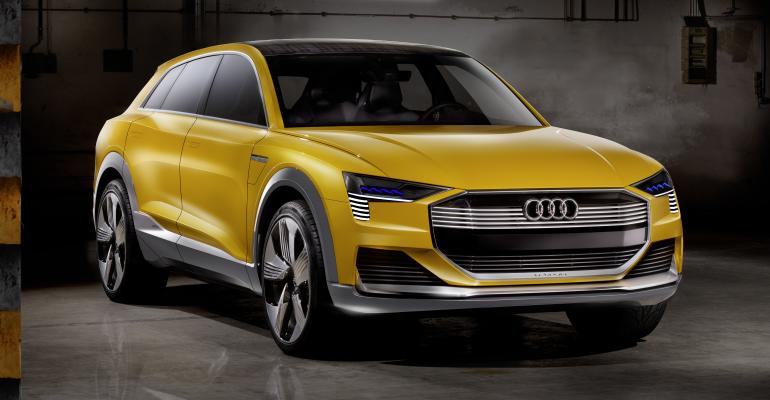DETROIT – Audi reconfirms plans to more than double down on electrification, as it rolls out a fuel-cell-powered concept vehicle here and pledges a raft of plug-in models by 2019.
Unveiling its h-tron quattro concept at the North American International Auto Show, CEO Rupert Stadler says sustainable transportation will be a key driver of Audi’s future product plans. Audi officials said earlier some 25% of U.S. sales should be electrified vehicles by 2025.
The squat, 5-door h-tron concept, likely the basis for a future Q6 offshoot, combines a 110-kW fuel cell with a compact lithium-ion battery. Housed beneath the passenger cabin, the battery acts like a turbocharger to supply up to another 100 kW of power during hard acceleration.
Audi says 0-62-mph (100 km/h) acceleration is achieved in less than 7 seconds, and top speed is governed at 124 mph (200 km/h) in the concept vehicle.
Three hydrogen tanks packaged beneath the passenger compartment floor and in a portion of the luggage compartment store enough fuel for 373 miles (600 km) between fill-ups.
Power is delivered to two electric motors, positioned on each axle, that serve as the quattro all-wheel-drive system.
Inside the h-tron spells out Audi’s future technology-laden direction, with curved OLED (organic LED) thin-film displays, next-generation steering-wheel controls and gesture control capability to operate key functions. Curved screens mounted along the door inners serve as digital side-view mirrors.
Closer to production are more plug-in hybrid models, which will join the PHEV Audi A3 e-tron now hitting the U.S. market and the hybrid Q5. Included in the plans is a PHEV version of the h-tron that presumably could be part of the Q6 line.
Stadler says there also will be plug-in versions of the A6 and A7 sedans within three years, as well as an e-tron version of the upcoming Q8, a new CUV that will be positioned above the Q7 in Audi’s lineup. A battery-electric vehicle also is in the works.
“(The) plug-in hybrid is priority No.1 (at Audi),” Stadler says following the h-tron’s unveiling. After that will come a fully electric CUV, “because that’s the request of our American colleagues.
“And the step after that is the fuel cell,” he says, adding market launch probably would come around 2020.
Audi’s PHEV push comes despite soft sales for the Q5 hybrid, totaling just 97 units last year.
“I think there are two things,” Audi of America President Scott Keogh says of the disappointing volume. “There’s the economic reason of low fuel prices. But I think the bigger reason is (fuel efficiency) is just not in the conversation in America anymore.”
Keogh says Audi plans to change that over the next few years.
“We think there’s a market here, certainly for us,” he says. “From what I can see, no one has really gotten all-in launching one of these cars. And by all-in, (we) use the strength of our 300-plus dealers, use a full-blown marketing campaign…$30-$40 million (and) use all the assets Audi has.
“That hasn’t happened for a BEV,” he adds. “(But) that’s certainly what we intend to do.”
Keogh predicts costs for electrified vehicles will come down sharply before the end of the decade, helping spur demand.
“If you look at the cost it takes to power something with a combustion engine and power it with a battery, they’re getting much, much more aligned,” he says. “In three years, from what we can see, it’s going to be cheaper to generate the same power from a battery than a combustion engine.
“That’s when you’ll really see the tipping point on that front.”





